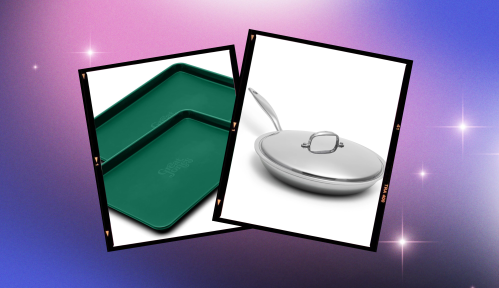Our editors independently select these products. Making a purchase through our links may earn Well+Good a commission
As the saying goes, variety is the spice of life. Applying the adage to foodie experimentation is a fantastic way to expand your palate and delight your taste buds… especially where dessert is involved. The next time you’re in the mood to make an ice cream sundae—whether for yourself, a friend, your significant other, or the whole family—we suggest whipping up a tamari caramel sauce to drizzle on top for sweet-meets-salty, oh-so-rich umami flavor (with perks for your gut and greater health, to boot).
Experts in This Article
registered dietitian and co-founder of the IBS Dietitian
director of marketing at San-J
Ahead, we’re sharing a simple five-ingredient tamari caramel sauce recipe, courtesy of San-J. But first: a quick explainer on what tamari is and some of the nutritional benefits it stands to offer.
What is tamari?
In case you’re unfamiliar with tamari, the condiment is also known as Japanese soy sauce. Historically, “it was discovered that a very tasty liquid was accumulated on the surface of miso1 (fermented soybean paste) during its ripening process,” explains Misako Binford, director of marketing at San-J. “The liquid was given the name tamari, or ‘that which accumulates,’ and began to be used as a seasoning.”
Tamari’s composition differs from that of standard soy sauce. Many varieties of tamari, including those from San-J, contain 100 percent soybeans and no wheat. Meanwhile, typical soy sauce consists of approximately 50 percent soybeans and 50 percent wheat, Binford explains.
Given that tamari tends to be wheat-free, it’s a great umami-rich alternative to soy sauce for those with celiac disease and gluten intolerance. As such, it can help these folks avoid digestive discomfort in the form of bloating and abdominal pain, says IBS dietitian Jessie Wong, RDN. She adds that the fermentation process used to make tamari also ends up supporting a healthy gut microbiome. But the perks don’t stop there.
“Tamari offers several nutritional benefits that make it more than just a flavorful condiment,” Wong continues. “It is rich in antioxidants—particularly isoflavones—which may help reduce oxidative stress.” Per a 2022 review in the journal Microorganisms, other soy and fermented soy products—including but not limited to natto, tofu, tempeh, and the Korean condiment doenjang—may also play a role in keeping chronic illnesses at bay, given their anti-inflammatory, anti-cholesterol, anti-cancer, and neuro-protective potential.
Why we love this tamari caramel sauce recipe
Frankly, there’s no reason not to love drizzling your ice cream of choice with tasty toppings aplenty. Making your own caramel sauce with tamari, however, can give it an unexpected oomph—not to mention freshness that beats alternatives that pack plenty of preservatives.
“During soy sauce fermentation, soy protein is broken down into amino acids, creating a balanced flavor with saltiness, sweetness, sourness, bitterness, and umami,” Binford shares. The end result: a veritable party for your palate. “Tamari gives the caramel sauce not only saltiness but also richness and complexity. Sweet and salty combinations are known to create layers of flavor which many people find delicious,” and this tamari caramel sauce is no exception.
Tamari Caramel Sauce Recipe
Yields 1/2 cup of sauce
Ingredients
3 Tbsp San-J Tamari Less Sodium Soy Sauce
3 Tbsp mirin
2 Tbsp honey
1/2 cup sugar
1/4 cup water
- 1.Mix San-J tamari, mirin, and honey into a heat-resistant bowl and microwave it for about 20-30 seconds to warm it up. Do not let it boil.
- 2.Put sugar and water into a heavy-bottomed saucepan and heat it over medium-high heat.
- 3.When the mixture comes to a boil, reduce the heat to medium. Do not stir the mixture, so as to prevent the sugar from crystallizing. Instead, swirl the pan gently until the sugar melts and turns golden.
- 4.Remove the pan from the heat and slowly and carefully mix in the warm tamari mixture into the pot, stirring gently.
- 5.Put the pan back on medium-low heat and heat the sauce, stirring for about 2 minutes.
- 6.Turn off the heat and let the tamari caramel sauce cool. The sauce thickens as it cools.
- 7.Drizzle the sauce over vanilla ice cream and enjoy!
If you have leftovers, Binford suggests storing the tamari caramel sauce in an air-tight container. “It stays fresh for up to one week at room temperature, and two months in the refrigerator,” she says. Since it hardens upon refrigerating, simply warm up the sauce before your next use.
Better yet, you don’t have to limit your drizzles to ice cream alone. “The tamari caramel sauce [also] works well to serve with French toast, bread pudding, whipped cream, flan or custard pudding, banana crepes, apple crisps, and most apple desserts,” Binford shares. It can even complement the flavors of popcorn, baked sweet potato, and sweet potato fries, thus offering no shortage of sweet opportunities to include this umami-rich sauce into your meal *and* dessert rotation.
Saeed, Farhan et al. “Miso: A traditional nutritious & health-endorsing fermented product.” Food science & nutrition vol. 10,12 4103-4111. 15 Sep. 2022, doi:10.1002/fsn3.3029
↩︎do Prado, Fernanda Guilherme et al. “Fermented Soy Products and Their Potential Health Benefits: A Review.” Microorganisms vol. 10,8 1606. 9 Aug. 2022, doi:10.3390/microorganisms10081606
↩︎
Sign Up for Our Daily Newsletter
Get all the latest in wellness, trends, food, fitness, beauty, and more delivered right to your inbox.
Got it, you've been added to our email list.











